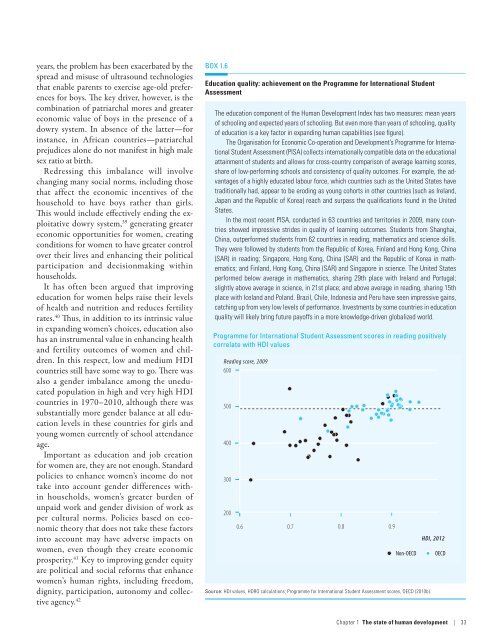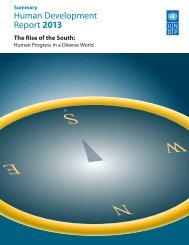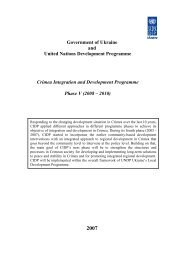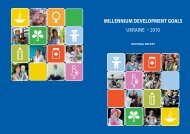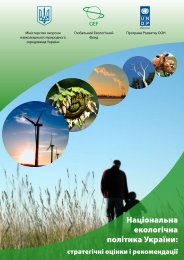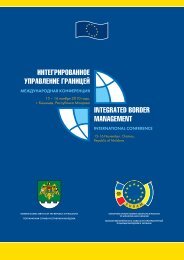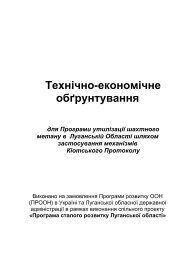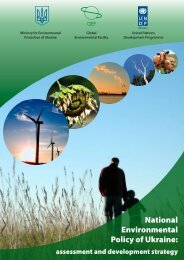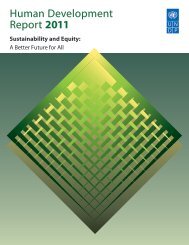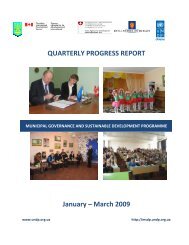E N S W - United Nations Development Programme
E N S W - United Nations Development Programme
E N S W - United Nations Development Programme
You also want an ePaper? Increase the reach of your titles
YUMPU automatically turns print PDFs into web optimized ePapers that Google loves.
years, the problem has been exacerbated by the Box 1.6<br />
spread and misuse of ultrasound technologies<br />
that enable parents to exercise age-old preferences<br />
for boys. The key driver, however, is the<br />
combination of patriarchal mores and greater<br />
economic value of boys in the presence of a<br />
dowry system. In absence of the latter—for<br />
instance, in African countries—patriarchal<br />
prejudices alone do not manifest in high male<br />
sex ratio at birth.<br />
Redressing this imbalance will involve<br />
changing many social norms, including those<br />
that affect the economic incentives of the<br />
household to have boys rather than girls.<br />
This would include effectively ending the exploitative<br />
dowry system, 39 generating greater<br />
economic opportunities for women, creating<br />
conditions for women to have greater control<br />
over their lives and enhancing their political<br />
participation and decisionmaking within<br />
households.<br />
It has often been argued that improving<br />
education for women helps raise their levels<br />
of health and nutrition and reduces fertility<br />
rates. 40 Thus, in addition to its intrinsic value<br />
in expanding women’s choices, education also<br />
has an instrumental value in enhancing health<br />
and fertility outcomes of women and children.<br />
In this respect, low and medium HDI<br />
countries still have some way to go. There was<br />
also a gender imbalance among the uneducated<br />
population in high and very high HDI<br />
countries in 1970–2010, although there was<br />
substantially more gender balance at all education<br />
levels in these countries for girls and<br />
young women currently of school attendance<br />
age.<br />
Important as education and job creation<br />
for women are, they are not enough. Standard<br />
policies to enhance women’s income do not<br />
take into account gender differences within<br />
households, women’s greater burden of<br />
unpaid work and gender division of work as<br />
per cultural norms. Policies based on economic<br />
theory that does not take these factors<br />
into account may have adverse impacts on<br />
women, even though they create economic<br />
prosperity. 41 Key to improving gender equity<br />
are political and social reforms that enhance<br />
women’s human rights, including freedom,<br />
dignity, participation, autonomy and collective<br />
agency. 42<br />
Education quality: achievement on the <strong>Programme</strong> for International Student<br />
Assessment<br />
The education component of the Human <strong>Development</strong> Index has two measures: mean years<br />
of schooling and expected years of schooling. But even more than years of schooling, quality<br />
of education is a key factor in expanding human capabilities (see figure).<br />
The Organisation for Economic Co-operation and <strong>Development</strong>’s <strong>Programme</strong> for International<br />
Student Assessment (PISA) collects internationally compatible data on the educational<br />
attainment of students and allows for cross-country comparison of average learning scores,<br />
share of low-performing schools and consistency of quality outcomes. For example, the advantages<br />
of a highly educated labour force, which countries such as the <strong>United</strong> States have<br />
traditionally had, appear to be eroding as young cohorts in other countries (such as Ireland,<br />
Japan and the Republic of Korea) reach and surpass the qualifications found in the <strong>United</strong><br />
States.<br />
In the most recent PISA, conducted in 63 countries and territories in 2009, many countries<br />
showed impressive strides in quality of learning outcomes. Students from Shanghai,<br />
China, outperformed students from 62 countries in reading, mathematics and science skills.<br />
They were followed by students from the Republic of Korea, Finland and Hong Kong, China<br />
(SAR) in reading; Singapore, Hong Kong, China (SAR) and the Republic of Korea in mathematics;<br />
and Finland, Hong Kong, China (SAR) and Singapore in science. The <strong>United</strong> States<br />
performed below average in mathematics, sharing 29th place with Ireland and Portugal;<br />
slightly above average in science, in 21st place; and above average in reading, sharing 15th<br />
place with Iceland and Poland. Brazil, Chile, Indonesia and Peru have seen impressive gains,<br />
catching up from very low levels of performance. Investments by some countries in education<br />
quality will likely bring future payoffs in a more knowledge-driven globalized world.<br />
<strong>Programme</strong> for International Student Assessment scores in reading positively<br />
correlate with HDI values<br />
Reading score, 2009<br />
600<br />
500<br />
400<br />
300<br />
200<br />
0.6 0.7 0.8 0.9<br />
Non-OECD<br />
Source: HDI values, HDRO calculations; <strong>Programme</strong> for International Student Assessment scores, OECD (2010b).<br />
HDI, 2012<br />
OECD<br />
Chapter 1 The state of human development | 33


